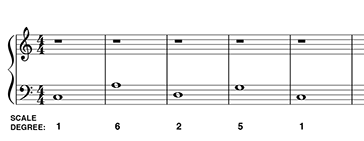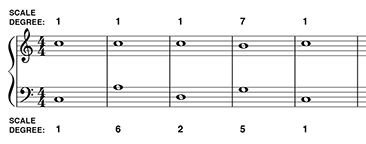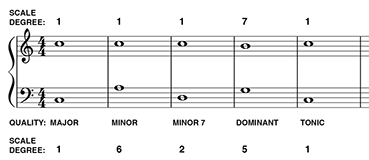
HOSTS- Jeremy Burns, Matthew Scott Phillips
TYPE- Ear Training
DURATION- 66:28
BUMPER MUSIC- "The Middle Road" (Area 47 Music)
ANNOUNCER- Mike Cunliffe
Continuing where episode 39 left off, this episode will review the previously discussed chords: I, II7, IV, V7 and VII (in major and minor) and their inversions. We will now add the III (the mediant) and VI (the submediant). Listen for the chord qualities (major, minor, dominant 7th, minor 7th and diminished) and use your theory brain to find out how to decipher chord progressions. Use this skill to learn songs faster and know music better!

MEDIANT (iii)- This chord is built on scale degree 3, a 3rd ABOVE the tonic. Here are some pop
examples that start off with movement to the
mediant chord:
-A Day In The Life (The Beatles)
-Ohio (Crosby, Stills, Nash and Young)
-Goodbye Horses (Q Lazarus)
SUB MEDIANT (vi)- This chord is built on scale degree 6, a 3rd BELOW tonic.
-It can be used as a predominant function, often
passing from I to V. Otherwise it’s function is
ambiguous.
-The vi chord is often heard in the deceptive
cadence (V -vi). But there are some voice leading
considerations:
-The voice that involves the LEADING TONE
should still resolve to 1.
-To avoid parallel 5ths or 8ves, the remaining 2
voices should move in contrary motion with
the bass.
-These considerations often result in the 3rd of
the vi chord being doubled.
SIMILARITIES
-Both of these chords are "flippity floppity". They are MINOR in the MAJOR keys. Likewise, the are MAJOR in the MINOR keys.
-Both of these chords are often effectively paired together, because of their relationship to each other (5th). This can be seen in Circle of 5th’s fragments (ex. iii - vi - ii - V - I, descending 5ths). In these cases, the iii chord usually precedes the vi chord.
Let's take four listens to identify this chord progression. Below is a good strategy on how to use your listens wisely for each time the progression is played.
1st LISTEN-THE BASS
Use this listen to focus on the bass line. In our first example, we hear the following scale steps in the bass, beginning with scale degree 1 (C):
1 - 6 - 2 - 5 -1
Notate it!

2nd LISTEN-THE HIGHEST NOTE
Use this listen to focus on the melody or the soprano voice. When you hear that note, try to identify what scale degree it is and where it goes from there. Sometimes singing (in your head), from the identified note down to the the tonic, can help zero in on what scale degree it is. In this case, we hear that scale degree 1 begins the following progression in the highest voice:
1 - 1 - 1 - 7 -1
Notate it!

3rd LISTEN-THE THEORY BRAIN
Something harmonic is coming together! We now have enough information to ENGAGE OUR THEORY BRAIN and start making educated guesses at how this progression might develop. Here's an example of the process:
1st CHORD
-I hear scale degrees 1 (bass) and 1 (melody).
-Both of these notes are in the tonic (I) chord.
-We are in a MAJOR key and this is sounds like a MAJOR chord.
-The tonic chord is always the same quality as the key its in.
Let's call this the I chord and see how that works!
2nd CHORD
-I hear scale degrees 6 (bass) and 1 (melody).
-The notes, A (6) and C(1) are both the SUB MEDIANT (vi) chord and in the SUBTONIC (IV) chord.
-We are in a MAJOR key and this sounds like a MINOR chord.
-In MAJOR, the IV chord is MAJOR and the vi chord is MINOR. So, it can't be the IV chord.
Let's call this the iv chord for now and try to listen for a confirmation that it's major next time around.
3rd CHORD
-I hear scale degrees 2 (bass) and 1 (melody).
-Scale degree 2 is the ROOT of the ii chord. Scale degree 1 is the SEVENTH of the ii7 chord. Plus it has a less stable sound. It sounds like a MINOR 7th chord.
Let's call this the ii7 chord for now and check out the next one.
4th CHORD
-This sounds like a DOMINANT CHORD and it contains scale degrees 5 (G) and 7 (B). We know both of those notes belong in the DOMINANT CHORD (G major).
This mystery is just about solved! Let's call this a
V chord and see if it leads to the TONIC.
5th CHORD
-This sounds like a TONIC CHORD and it contains scale degrees 1(C) and 1 (C). We know both of those notes belong in the TONIC CHORD
(C major).
Let's call this a TONIC. It sounds like the end of
the race and it confirms our guess at the previous DOMINANT CHORD, because that's where it wanted to resolve.

4th LISTEN-CONFIRMATION
Ideally, this listen will be your confirmation listen. Check out all the voices you filled in and make sure they make sense with what you're hearing. Fill in the middle voices (the ALTO and TENOR),
if you haven't already.
Here's what it will look like.

NOW LISTEN AS WE APPLY THIS APPROACH TO THE NEXT EXAMPLES
-When trying to determine which scale degree is in the highest voice, try singing down the scale from that note. If you feel you've reached the TONIC on the 3rd note down, that note is the 3rd. If you can keep going, perhaps not.
-Try practicing progressions using these chords, using CHORALE or KEYBOARD styles.
-Don't neglect the MINOR keys while working on these progressions.
-Try to get good at singing "in your head" or to your self. When you hear a chord, try to arpeggiate the notes in your head.
-Try to get good at identifying the bass lines when listening to music. These will be the first that you will want to identify when taking your listening exams.
-Budget your listens wisely. First identify the lowest notes. Second, identify the highest notes. Use the third listen to engage your theory brain and then the fourth to confirm.
